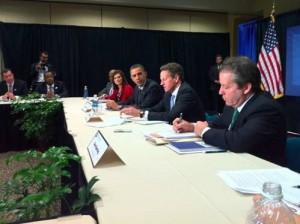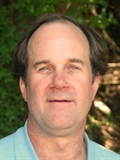
Greg Ayers, (not pictured, behind the water bottle on the lower right) attended a Forum on Small Business with President Obama and Cabinet advisors last month
Sometimes government moves so slowly, you almost think it’s comatose.
And then there are the times, as Dr. Greg Ayers learned last month, when you scarcely have time to turn around before you’re meeting face-to-face with the U.S. President, advising him and his cabinet.
Ayers took part with 120 other businessmen in a roundtable discussion on Feb. 22 in Cleveland Ohio, “Winning the Future” Forum on Small Business. Moderating the discussion was President Obama and members of his cabinet, including former Washington State Governor Gary Locke (current Secretary of Commerce and proposed as U.S. Ambassador to China), and Secretary of the Treasury Timothy Geithner.
Ayers had been asked to attend the meeting in an email (which he googled for credibility) just the week before, and wasn’t sure if it was a political “speechifying” event or not.
At the beginning of the meeting, President Obama asked for input – positive or negative – on ways the federal government could create and foster programs to help businesses “on the street.” Ayers says that for the most part the invited business people were positive, discussing programs that they have used, and ways to make them better.
The participants were demographic counterparts to Orcas Island business owners, in that the challenges they face — running an insurance company or a restaurant, to give two examples — are similar to those faced by the situations commonly faced here on Orcas Island: how to remain in existence; to expand product lines or customer base; to increase employment.
The makeup of the at-large group at the three-hour meeting was about one-third service providers, one-third retail and one-third high tech, Ayers said. There was also some representation from the manufacturing industry, and manufacturing topics included re-tooling the products made for heavy industry and developing high-tech solutions in their place, such as replacing galvanized metals with stainless steel, for s greater applicability; or changing from large equipment manufacturing to making component pieces of products used in biotechnology or electronics.
Once the photographers were allowed a “photo opp” and shooed out of the conference room, President Obama gave a 20-minute speech and instructions for breakout sessions for the Small Business Forum. Then it was down to business as groups of 20 business representatives met, each group with one cabinet-level advisor to address differing topics:
- Providing tax cuts and creating jobs to help small businesses
- Expanding access to capital
- Expanding entrepreneurship and mentorship programs
- Strengthening and educating the workforce
- Identifying and removing export barriers; expanding overseas
- Investing in new clean energy technologies
Ayers, who is the CEO of an Ohio company called ViewRay ( which holds the patent and has built the prototype for a radiation-directing device used in treating cancer), met with Secretary of the Treasury Timothy Geithner. Ayers’ smaller group was focused and how small businesses can gain access to additional capital funds and, by extension, how they can hire more employees. Members of the group were asked to give their insights into how their business runs; how they secure funding; and how the government may improve on new programs that have proved promising.
Ayers, who holds an M.D. in cardiology, specializing in electro-physiology, and a PhD in Biomedical Engineering, has more than two decades of experience working with medical device start-ups and venture capital firms, serving as CEO, medical director, or board member of more than a dozen medical device companies. He holds 21 U.S. patents. He joined with View Ray to design and make available technologies that would benefit patients. The process involved designing, securing patents and making feasible the radiation-monitoring device.
Ayers has been instrumental in several capital fund-raising campaigns to bring the therapeutic radiology device to market. The first campaign raised $3,000,000 to work on patents, refine the concept and write the business plan. In 2008, an additional $25 million was raised from four venture capital funds. Last summer, $20 million more was raised by View Ray.
He has been involved in the start-up of 15 to 18 start-up companies, most of which have gone public or been acquired by larger companies. Ayers says the success of a start-up depends on making sure the business provides something that people really need and that isn’t already being provided. “You have to take the risk,” Ayers says, in that there be a prolonged period of time in which there is little financial gain from the business:
“You can’t just half-way go into it. To a certain extent, it’s self-selection: you have to have the trait of feeling comfortable taking risks. “
“If money is your only driver, it’s hard to immerse yourself, because with start-ups, you’re paying yourself very little at the beginning. You have to believe in your idea to make money – and everyone participates in building the value.”
With his experiences in start-ups and venture capital, at the meeting Ayers brought up a tax credit program that was originally sponsored by Arkansas’ Senator Mike Pryor. The terms of that program are intended to give a 25% tax credit over three years to individuals who invest in start-up companies or new, small businesses. The program began last year and is applicable in the 41 states that have a state income tax.
About a half-hour into the breakout conversation, the President came into the room and sat down to listen to the group. He stayed for about 45 minutes.
Ayers found the discussion to be open-ended, with Geithner and Obama asking follow-up questions to fully understand the discussion. Ayers described the two men as both “extraordinarily intelligent and thoughtful, engaged and inquisitive” in thinking through the processes and options brought up in the forum.
“Winning the Future,” the President’s strategy for stimulating business and employment, using small businesses, had been a major part of Obama’s 2011 State of the Union address, Ayers said. The Feb. 22 Small Business Forum was “not what I would have expected; it was more like a business meeting, or a report to a school or medical center board of directors.
“It was a true discussion of ideas and concepts, not an autograph session or a photo opportunity.”
Ayers and his wife Pat moved to Orcas in 2006 after spending some time in Redmond with his first start-up company and then moving to California’s Bay Area. They always wanted to move back to the Northwest to enjoy boating and the way of life. When they Ayers were married at Rosario Resort, they began looking at Orcas Island as a place to live fulltime; a goal they’re approaching as they purchased and property and starting building their own home.
Greg Ayers serves as a Commissioner on the Eastsound Sewer and Water District, and Pat is Vice-President of the Orcas Island Prevention Partnership; she has also been seen on the stage with the Actors Theater of Orcas Island.
**If you are reading theOrcasonian for free, thank your fellow islanders. If you would like to support theOrcasonian CLICK HERE to set your modestly-priced, voluntary subscription. Otherwise, no worries; we’re happy to share with you.**








